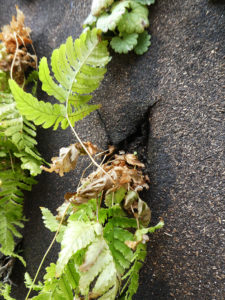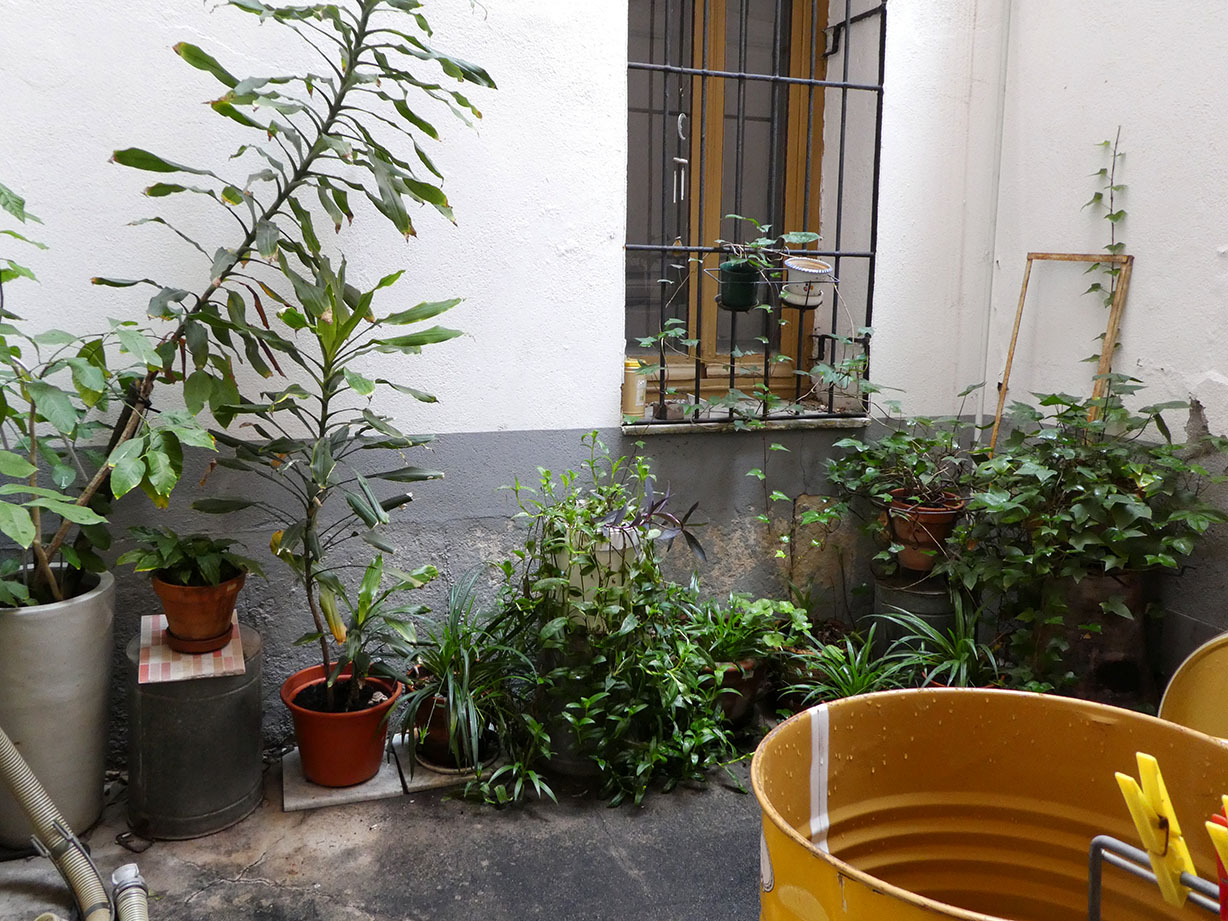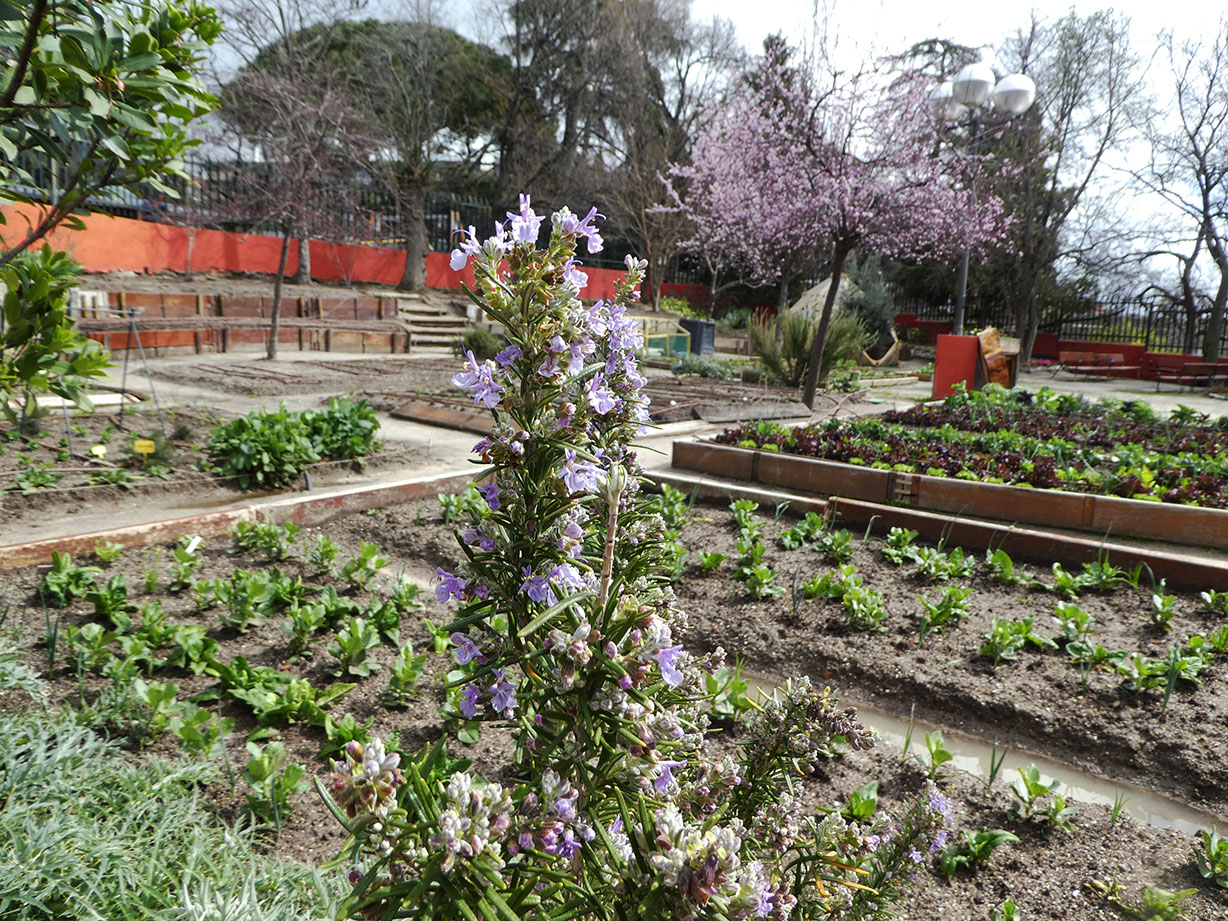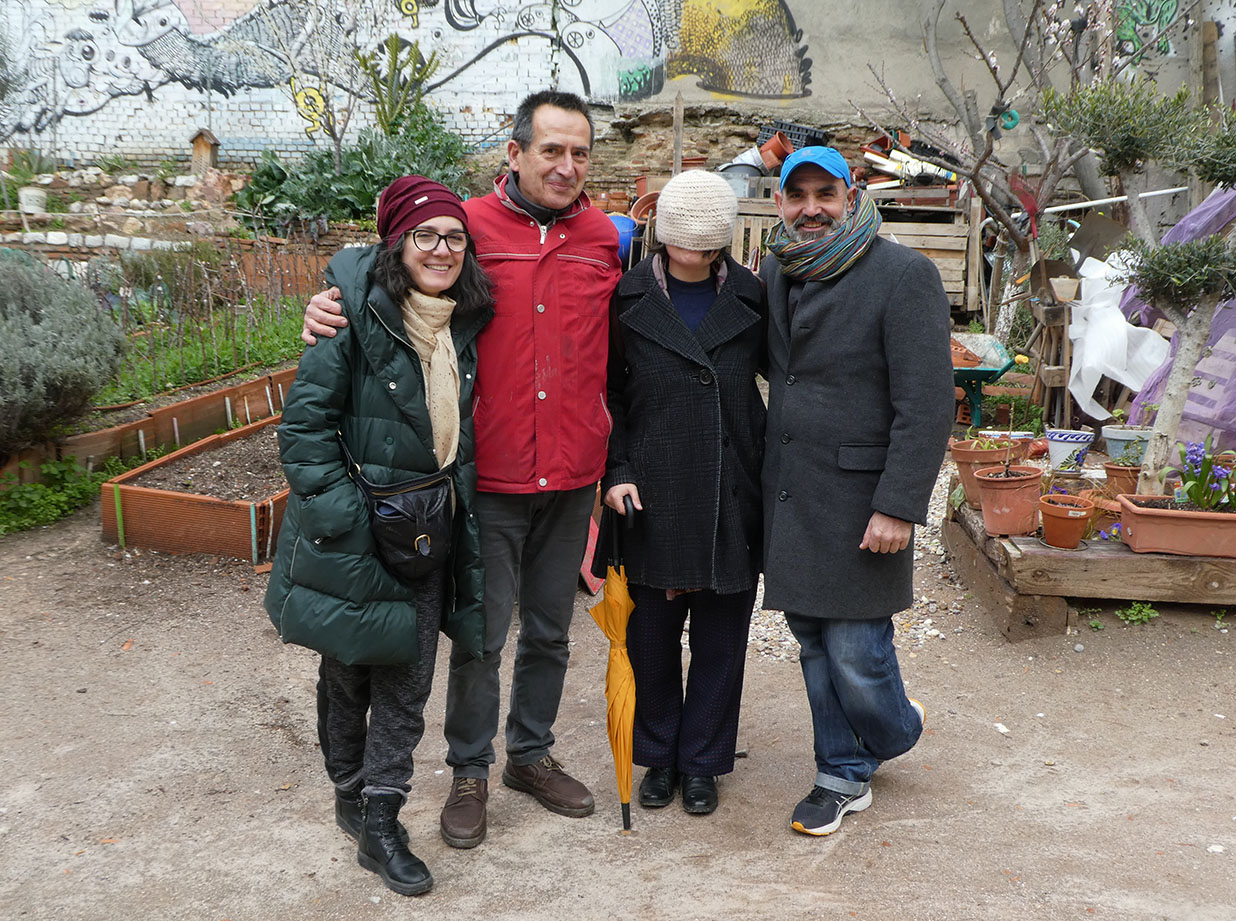
Read More
Berichte und Bilder aus verschiedenen Gärten der Welt

Eva Kurly and Oscar Dominguez at the Hospital de Plantas
(Übersetzung folgt) It’s less than a 20 minutes drive into the western part of Madrid and we reach the community of Pozuelo, famous for its singular „Hospital de Plantas“. As we get out of the car, the air feels different. Humid, a bit „foresty“ with a tinge of swamp. The rain falls softly on my face and onto Eva’s umbrella as we make our way to the entrance of Aula de Educación Ambiental (Húmera).

Eva Kurly had worked here for three years and arranged the interview.

Main office
The area is huge. We walk past greenhouses, wooden office buildings, plots and raised beds, and a geodetic dome used as a surround cinema. One of the educational directives of this place is the fostering of sustainable energies and waste upcycling. We pass a dew collector, solar panels (one in the shape of a giant sunflower, that alines its movement with the course of the sun) and a solar oven.

Smart solar energy plant
The fences hold plastic bottles cut out to hold plants of all sorts… due to the season most of them are „wild herbs“. Again much of the work invested into the huertos is done by volunteers and/or within the frame of education classes organized by the municipality.
The Hospital de Plantas is run by Oscar Domínguez, a biologist who teaches about plants and plant deceases at the university. There are regular opening hours once a week at Wednesday 10-2, when the citizens can come and bring their sick plants. A cupboard holds a microscope and various instruments to examine the patients and decide on the treatment.

Patients get a label
Once hospitalized, the length of stay depends on the recovery process. For some plants, this can take up to a year, like in the case of a leafless, shriveled bonsai. Oscar put another case on the „Mesa de tratamiento“, a deplorable looking orchid in possession of none but one (broken) areal root. He points at some knobs in the centre of the plant. There is still hope, he says.

A classical patient

A snails sails across the table. It will be put out into the open
With such a long stay, I ask, how often does it happen that the owners won’t fetch their plants back?
Often, Oscar says. People just give up too easily. They are not used to care for plants in a sincere way.
Yet, if a person cannot take care of a plant, this shows that this person is also neglecting his or her own personality, or at least part of it.

Hospital watering can
Our conversation, facilitated by Eva’s translation, consequently drifts to the psychological impacts of plant ownership and care. Older people for example would often prefer plants that are easy to care for and grow rather slowly while young people love quick growth and plants that produce an abundance of colors both in leaves and flowers.
– The interview is presently in the process of editing and will be online in due time –

Oscar Dominguez, Hospital de Plantas
A second branch of Señor Dominguez’ research work is the construction of vertical gardens and the exploration of their micro climates. The one shown here is wainscoted with felt and allows a natural circulation of water, light and microorganisms within the unit.

We leave the „Classroom of Environmental Education“ of Pozuelo for a little walk in the nearby Casa De Campo. Once a hunting ground for the royals it is now Madrid’s biggest park covering more than 1,750 hectares. (I leave the touristic details aside here). There is anthother hospital in the vicinity: A hospital for night birds. There is not much hope to meet somebody there. Eva tells me she’s tried already several times. We are more than surprised that the door actually opens…
Yet, cheered too soon: No, no es possible! The staff is just at lunch and the birds are sleeping and must not be disturbed.

Stork’ nest Casa de Campo
Very wide awake instead are the storks that keep flying almost around our heads. Bundles of twigs hang from their beaks and indeed, Eva points out to a huge nest in the top of a nearby tree.
Two other features of the Casa des Campo: Swarms of green parrots that also nest here and pose (as in many other cities – also in Germany – ) a treat to the native birds, especially the common sparrow (which grows less and less common). Second, hoards of ghostly shaped trees, with hollow trunks and often reaching into the air with one last twisted branch. We put the recorder for the bird sounds into the fork of one branch and walk around… there is this „silky grey“ filter on my camera I try out.

Nest of the “evil” green Parrot

Ghost movie trees
 (Übersetzung folgt) La Casa de la miel has been in the hands of his family ever since the shop was founded in 1942, its owner, Pedro Pajuelo, says. We are standing in front of the counter, a black board next to the door shows the different kinds of honeys sold here, a shiny bin with a giant bee printed on it decorate the counter as well as an old-fashioned scale made from white enamel.
(Übersetzung folgt) La Casa de la miel has been in the hands of his family ever since the shop was founded in 1942, its owner, Pedro Pajuelo, says. We are standing in front of the counter, a black board next to the door shows the different kinds of honeys sold here, a shiny bin with a giant bee printed on it decorate the counter as well as an old-fashioned scale made from white enamel.

Two other men work here, one of them dusts the shelfs with the honey glasses with a feather mop, the other walks to and fro between the back rooms and the counter. An old lady enters and asks for a bag of bean seeds.

La Casa de la Miel does not only sell honeys from different regions of Spain, but also vegetable and flower seeds, teas, herbs, pimiento and other spices, cosmetics made from honey and pollen (the best quality is stored in a fridge in the corner). There are also little boxes with violet sweets in them in the color of violets! A speciality of Madrid, Pedro explains.

But of course, we talk about honey, its origins, how prices rise with the decrease in production because of the bee pests. If the bees die, we’ll have nothing to eat after no time, Pedro says, maybe five years, no more.
The conversation is in Spanish, I ask and Alberto assists with translation. 300 words in Spanish seem to equal 30 in English. I understand fragments and then, at times, I have no clue. Yet, this recording is for Datscha Radio Madrid, and almost a third of the world’s population speaks Spanish anyway :)

It is a rule with interviews that when the moment comes you think it is finished, the real info are preisgegeben. He hands us both a jar of honey com regalo, I present my flyers with the Adopt a Plant thing happening this Saturday and upon this information Pedro reveals himself as being a gardener too.
“Realmente me gustan las plantas. Come come…“
Alberto and I get invited to follow him to the store rooms in the back of the shops where huge barrels of honey sit on a tiled floor and a machine to knead the honey to a more fluid consistency dominates the room. We enter the patio of the house which belongs to the few still in their original architecture existing ones in Madrid: made of wood and stone but with a metal skeleton inside.
In the patio plants are lined up, lush green leaves, palm like. An „Indian plant“ was saved here from being thrown away. This is also the habitat of an ex-Christmas tree which seemingly thrives at his now home. And there is still another patio filled with Trandesceana, begonias and “bad mothers”. So there’s a secret gardener! Pedro explains that he likes to pick up the remnants or off shoots from neighbors plants falling into the yard. He gives them a new home and cares for them.

Then one of his shop attendants calls out about an important customer having just arrived, and we say goodbye and step out of the House of Honey into Atocha Street.
Read More (Übersetzung folgt) Here’s a very quick update on what is happening in Madrid with Datscha Radio – and an diary of how I spent my day so far.
(Übersetzung folgt) Here’s a very quick update on what is happening in Madrid with Datscha Radio – and an diary of how I spent my day so far.
9:20
Call from Carolina from Radio Hortelana to say that we meet in a different place at 10:45. I’m at my first coffee and not fully awake. Writing quick mail to the collaborating artists (which will be introduced here asap) about next plans, ideas & meeting.
10:45
Walking very fast up to the Casa Endencida to meet Elena and Caroline from Radio Hortelana. Introductions, coffee, explaining Datscha Radio Madrid.
The plan: Setting up the radio station in the urban garden of Esta es Una Plaza. Date: Friday 23rd of March. Before that: Adopt-a-Office on the 17th in the yard of MediaLab, little performance by myself, conversations about plants that seek a new home.
Question: Is there electricity in the garden?
I am very happy that Radio Hortelana (who did a garden broadcast at Esta es Una Plaza some years ago!) will help with the project! We agree that I send a resume of all facts to Elena, Caroline and the Insonora network tonight.
11:15
Introduction to Daniel Sigler, who had been sitting next to us reading El Pais, a friend of both, a gardener, keeper of the garden “Cabaña de Retiro”. He loves the idea.
12:00
We all go to Esta es Una Plaza to find out about electricity.

Caroline Carrubba (Radio Hortelana), Luis Elorriaga (Esta es Una Plaza), Elena Arroyo (Radio Hortelana) and Daniel Sigler (La Cabaña de Retiro)!
I get introduced to Tommi (Carolina: “He’s the best”) who would help with technical things, and to Luis who explaines that there is solar powered electricity. He shows us the transformer and the plugs in the different places in the garden. I update my Spanish vocabulary with the word grabadora (Recorder). I get introduced to more helpful people.

The home of electricity in Esta es Una Plaza!
12:45
Leaving the Plaza to go to the agricultural market in the Retiro Park. Stormy weather. I walk with Daniel who tells me about his garden project there. He also tells me about his work as a shiatsu practitioner and that he can do throat singing. I love the idea.
13:00
On reaching the Retiro I decide to switch on the grabadora, our conversation is just too interesting. There is the recorder, rain and Daniel’s umbrella. I don’t carry one for diverse reasons, but he says it’s because i am German.
We reach his „garden within the garden“ called Aula de ecología: La Cabaña del Retiro. He shows me around (gallery and more about La Cabaña in a later post). There is a hand made wooden geodetic tent with cut-outs that let the sun shine in and make pattern on the floor. It is a good place for singing, also because of its special resonant qualities.

All handmade from wood, a house for contemplation
Daniel asks me to close my eyes and starts singing. I sit on the wooden trunk in the middle of the space, listen and record. (Recording of audio walk and singing: to be broadcast on 23rd:) )
13:45
Salad needs to get picked to bring to the market. I receive a selection of healthy greens and explain the German onomatopoetics of „Pflücksalat“.
14:00
Walk to the Mercado Agroecológico en el CIEA Huerto del Retiro that takes place in another garden (section) of the Retiro: Stalls with honey, cheese, biologically brewed beers, jams and quiche. I am hungry and need to eat, try and buy specialities.

Agricultural market in El Retiro at closing time

Happy plots at the Retiro Garden
14:30
Introduction of Alberto, head of the Huerto del Retiro. Agreement to do an interview via Daniel as a translator. Saying goodbye for this time. Tasting a lovely bio Weizenbier! Taking some pics, among them the map of urban gardens in Madrid. What you see here is just a quarter of it.

14:45
Return to Medialab through rainstorms. Making a mental note to maybe take pictures of Madrid dogs that wear raincoats.
15:10
Arrival at Medialab, switching on the heater, sitting down to write this.
… so far. All dates and times mentioned will be verified very soon as exta blog posts, Facebook events and other possible channels.
Read More
7.3.2018 Today’s excursion to the periphery of Madrid brought on a flood of images and sounds. The aim was to visit Parque Capriche while obstinately ignoring the note „closed today“ on my phone.
Leaving the metro at Capriche (instead of the advised station of Cnajallmos) I directed my steps to the close-by grove of cypresses, gravel paths leading past unkempt lawns when I eyes caught sight of a typical enclosure with a vertraut sign reading: Huerto Allameda de Osuna.
A friedly looking couple stood conversing in front of a compact rusty shed, plots aligned the paths, buckets and wheelbarrows in a corner: Clearly this was another of Madrids happy urban gardens. (A detailed entry follows.)

After leaving the huerto I continued in vague direction of the Parque Capriche sign. Julia and Floren also had asserted that this garden wouldn’t open its doors before Saturday.
The area was already park-like: strewn with cypresses, trees with an abundance of cream-coloured berries (Medlar? Mulberry?), dog walkers, blue sky, sun. To my right a wall covered in graffitis. To my left beige brick apparent houses loomed next to more beige brick apparent houses. Council houses? Condos (Hardly)?

I followed the winding display of murals in the shadow of the wall. Used paper towels, plastic bottles, packagings, decorated the lawn: urban nature par excellence. On my phone, the blue spot indicating my position kept on hovering in the pathless green, creating the surreal feeling of somehow having been shrunk to half my size with distances doubled… Maybe this was because I felt the need to visit an aseo.
More images of the wonder wall on Facebook.

The closed gate of the Parque Capriche did not offer more to see than an impressive stretch of gravel leading up to an entrance building flanked by – no surprise – platanes. The murals had ended at a motorway crossing. There was an aqueduct in sight with trains running on it. On the other side of the street a spotless white wall opened up into a patio, and a friendly restaurant sign declared this to be the „Camping Osuna“.
Una tortilla, una cerveza, un cafe, muy bien!
Parque Juan Carlos: Thank you for not being neoclassical!!! Thank you for offering a place in space under a sky that sheds its blue-and-golden light onto industrial beauties, utilitarian architectures, the most aesthetically designed Staudamm I have ever seen, Mexican monuments, olive and juniper groves, futuristic playgrounds, grand alleys with – surprise! – not absolutely symmetrically arranged shrubs/trees. Thank you for emptiness!

(Detailed entry follows.)
Best of all: The Grey Maze! Undoubtedly the home of countless happy rabbits (I saw only two -huge!- ones, but it was afternoon not evening). Parrots cut through the air, screeching, but still in a civilized manner compared to their relatives in Australia. Tiny birds twitter on twigs. Youngsters practice Kajak polo, a sport I never heard of before.
A twig of the maze hedges – unknown plant to me – wandered into my bag for further identifucation.
Read More
 (Übersetzung folgt) A most depressing sight for all not plant-affine persons: A rose garden in early spring! Prickly bare sticks sprouting from grey-brown knotted knobs, one next to the other, the very image of bristly boredom. Quite different so for the rose lover: She or he wanders among the plots, reading the signs with avid interest and from time to time sends out deep mental sighs of expectation in view of „Red Mozart“ or „Conquistador“ or „Boule de Neige“. I see names I never read before in any books or on websites. No wonder, since La rosaleda de Ramón Ortiz“ features an important collection of varieties of Spanish roses, and the garden also serves as a test plot to see how these roses handle the Spanish climate.
(Übersetzung folgt) A most depressing sight for all not plant-affine persons: A rose garden in early spring! Prickly bare sticks sprouting from grey-brown knotted knobs, one next to the other, the very image of bristly boredom. Quite different so for the rose lover: She or he wanders among the plots, reading the signs with avid interest and from time to time sends out deep mental sighs of expectation in view of „Red Mozart“ or „Conquistador“ or „Boule de Neige“. I see names I never read before in any books or on websites. No wonder, since La rosaleda de Ramón Ortiz“ features an important collection of varieties of Spanish roses, and the garden also serves as a test plot to see how these roses handle the Spanish climate.
The gaze travels from base to top, inspecting the expertise of how the stems have been cut, and at what height, it admires the raffia bows tenderly wound around the twines for support and the colours of the first leaves: dark copper, crimson red, emerald green, orange tinted, etc
The rose lover knows some of the names, but there still remain hundreds of floral secrets to dream of. The garden hosts 600 varieties and 20 000 specimens and as an average gardener one cannot possibley know more than maybe three dozens of them… or?
The Rosaleda Ramón Ortiz – who then was the main gardener of Madrid – was created between 1955 and 1956. It is situated in the Parque Oueste, in the western part of the city. There is bird song and the rush of cars on the Paseo del Pintor Rosales, there is a fountain with a white lady spreading her arms under a spruce (or what I take for one). There is a group of young men dressed in blue and yellow overalls chatting at the corner of a long streched building next to the public toilets.
Let us walk up to one of them. His name is Oscar:
Read More

(Übersetzung folgt) Another rainy day and a visit to the Sabatini Gardens in the western part of Madrid, close to the Palace del Rey. I went there intrigued by some pictures showing topiaries and I was not disappointed.
Beheaded cypresses flank the paths, darkly clothed guards of sharply trimmed hedges and the enclosed ponds that hold water spluttering ananas shaped stone sculptures.
I have a weak spot for topiaries, especially when they sprout extra twigs or have “faults” that turn them even more into seemingly animate beings. Another feature of the garden are the sculptures of quite a dozen of Spanish kings that obstinatly turn their backs to the tourists and visitors and look across the main pond at each other. Wrapped in their white, often cracked and partly patched cloaks, they royally withstand the rain, evidently glad for having escaped from a much more boring surrounding, an ordinary storage space.
As far as common information goes I’ll just share this wiki note with you:
Read MoreThe Jardines de Sabatini are part of the Royal Palace in Madrid, Spain, and were opened to the public by King Juan Carlos I in 1978. They honor the name of Francesco Sabatini (1722–1797), an Italian architect of the 18th century who designed, among other works at the palace, the royal stables of the palace, previously located at this site.
In 1933, clearing of the stable buildings was begun, and construction of the gardens begun, which were only completed in the late 1970s. The gardens have a formal Neoclassic style, consisting of well-sheared hedges, in symmetric geometrical patterns, adorned with a pool, statues and fountains, with trees also disposed in a symmetrical geometric shape. The statues are those of Spanish kings, not intended originally to even grace a garden, but originally crowding the adjacent palace. The tranquil array is a peaceful corner from which to view the palace.
 ¡Hola Jardineros! Machen wir einen Spaziergang mit Alberto Peralta zu “Esta es una Plaza” in Madrid, einem Gemeinschaftsgarten in der Nähe des Medialab Prado. Die Wolken hängen heute tief, die Leute kuscheln sich unter ihre Regenschirme, doch hier in der Calle Doctor Fourquet, 24, ist die Luft erfüllt von Sägegeräuschen, Gesprächen und dem Platschen der Schuhe in sandigen Pfützen.
¡Hola Jardineros! Machen wir einen Spaziergang mit Alberto Peralta zu “Esta es una Plaza” in Madrid, einem Gemeinschaftsgarten in der Nähe des Medialab Prado. Die Wolken hängen heute tief, die Leute kuscheln sich unter ihre Regenschirme, doch hier in der Calle Doctor Fourquet, 24, ist die Luft erfüllt von Sägegeräuschen, Gesprächen und dem Platschen der Schuhe in sandigen Pfützen.
Der Gemeinschaftsgarten “Esta es una plaza” bestand fast 40 Jahre als páramo (städtische Brache). Vor 10 Jahren beschlossen die Einheimischen, sie in einen Garten zu verwandeln. Es gab, wie Alberto mir erzählte, sogar finanzielle Unterstützung seitens der Stadt für die Gärtner, aber diese entschieden so unabhängig wie möglich zu bleiben … also ist sogar noch etwas Geld übrig. [unglaublich!!!]
Der Garten ist etwa 1000 Quadratmeter groß und umgeben von bemalten Backsteinmauern. Darin stehen neben einem halben Dutzend junger Obstbäume und sorgfältig gepflegter Beete auch mehrere in Handarbeit konstruierte Bauten für die Arbeit, Mahlzeiten und Schutz vor Wind und Regen. Es gibt auch einen Spielplatz und sogar ein Theater in hinteren Teil des Gartens. Die Kerngemeinde zählt etwa 30 aktive Mitglieder, aber nicht alle sind Gärtner. Einige kümmern sich um Beetumfassungen und Bauten, andere meistern die Logistik oder auch die Außenküche oder beides, wenn es darum geht, die Früchte des Gartens untereinander zu teilen: Im Sommer und Herbst werden regelmäßig Mittags- und Abendessen organisiert.
Auffallend sind die Wandgemälde und Graffitis, die ebenfalls aus der Gemeinschaftspraxis dieses Gartens hervorgehen: Wer zu “Esta es una Plaza” beitragen will, tut dies, indem er seine/ihre Idee vorstellt – und bekommt dann (in den meisten Fällen) einen Zeitraum und Ort zur Verfügung gestellt um sie zu realisieren. Die Künstler*innen dürfen bis zu 6 Monate an ihrem Werk arbeiten. Die große Holztafel, die die Sechsfüßler unserer Gärten illustriert, wurde vor übrigens vor 4 Jahren von einer Biologin namens Zeeba geschaffen. Ähnlich freie Arrangements gelten für Workshops, Konzerte und Theaterstücke … und sicherlich verdanken auch einige der überall verstreuten DIY-Gartenkunstwerke ihre Existenz dieser freizügigen Praxis.
Eine Besonderheit des Orts ist der Kakteengarten, der von Antonio Alfaro entworfen wurde und seitdem liebevoll von ihm gepflegt wird. Hunderte sorgfältig angeordneter Exemplare leben hier auf drei Steinterrassen, in Gemeinschaft mit weiteren Sukkulenten und – wie ein zweiter Blick offenbart – einem “Club” unaufdringlich charmanter Artefakte … una lagartija (Eidechse) … un erizo (Igel) … und mehr. Das erstaunliche botanische Wissen, das sich in der Kakteenlandschaft zeigt, erklärt sich schnell: Antonio ist Mitglied der “Cactófilos” oder mit anderen Worten der ASOCIACIÓN CACTUS Y SUCULENTAS DE MADRID :)
Dank an Alberto für diesen Tipp!
Read More